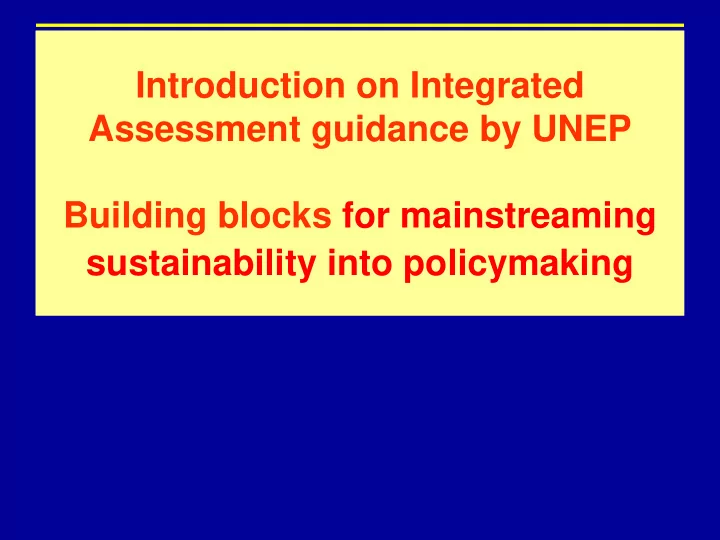

Introduction on Integrated Assessment guidance by UNEP Building blocks for mainstreaming sustainability into policymaking
Aims 1. Document and share knowledge based on experiences, focused on practices to stimulate an integrated and pro- active (ex-ante) assessment approach. 2. Make assessment less procedural and more flexible, tailored to different contexts and policy processes, by adopting a ‘building-block’ approach of conducting IA. 3. Support policymaking for sustainable development, with a view to embedding sustainability within policymaking processes (IA not implemented as an isolated exercise, but as an integral part of a policymaking process).
Integrated Policy making • See IA approach in close conjunction with the initiative on developing Integrated Policymaking for Sustainable Development. The aim is to improve decision-making. • Since 2005, UNEP took steps to encourage Integrated Policymaking for sustainable development (IP) by increasingly placing IA tasks and activities within the overall policy cycle. • While IA is to be closely linked to the policymaking process, policymaking processes can contribute to sustainable development by effective use of the IA building blocks.
Four key features of the IA approach • Full sustainability / ESE integration - full integration of the three sustainable development (economic, social, environmental) dimensions; • Integration in policymaking process –the IA building blocks are to be integrated in the policymaking process, at an early stage and at a strategic level, in order to contribute to policy formulation; • Proactive and strategic approach – a proactive approach will help develop policy options that generate sustainability outcomes and benefits – for instance by enhancing Green Economy strategy; • Flexibility by building blocks – because policymaking processes are variable and largely unpredictable, building blocks are proposed to be used in variable sequence and intensity and tailored to different types of policymaking and planning processes.
Building blocks – 3 categories • The process. The organisation of the IA process in relation to the policymaking process. • The policy institutional context. This refers to the institutional context of the policy, and the IA objective to bring about positive change. • The IA analytical contents. This is the actual ‘technical’ part of the IA.
12 Building blocks A. Process B. Policy C. Analytical institutional context Contents A1: Process design and links B1: Institutional analysis and C1: Strategic framework and change identification of key sustainability issues A2: Policymaking decision B2: IA team organisational C2: Trends and scenarios windows model A3: Communication strategy B3: Stakeholder engagement C3: Identification of and strengthening civil opportunities and formulating society alternative policy options B4: Evaluation and learning C4: Assessment of risks and benefits. C5: Monitoring and evaluation
Building blocks - details Building block Minimum requirements A1: Process design and links Understanding of the policymaking process, and design of the IA process that fits the policy-making process and enhances linkages. A2: Policy decision Appropriate timing of inputs into the policymaking process and preparedness to make use of policy windows windows if and when these emerge; packaging of key messages and delivering these at the right moment to the right person/s. A3: Communication Communication throughout the IA process with strategy use of adequate communication tools (e.g. policy briefs, briefings, webpage), to timely and effectively inform key decision-makers.
Building blocks - details Building block Minimum requirements B1: Institutional analysis Understanding institutional strengths and and change weaknesses responsible for unsustainable development patterns in the relevant sector/s and institutions; design of institutional changes. B2: IA team organisational Adoption of an efficient organisational model of model the IA team that has direct linkages with the policymaking process. B3: Stakeholder engagement Key stakeholders are identified and actively and strengthening civil engaged in a transparent and functional manner, society during the IA and policymaking processes. This will contribute to strengthening of civil society. B4: Evaluation and learning Effectiveness of the IA process in relation to its set purpose, and lessons are identified as part of an institutional learning and strengthening process.
Building blocks - details Building block Minimum requirements C1: Strategic framework and Defining sustainability objectives, with associated identification of key policy objectives and indicators, and a simple sustainability issues analytical framework to demonstrate the main interrelations and causal relations. C2: Trends and scenarios Trends of key sustainability issues are established and linked to the policy process, design of at least two simple scenarios. C3: Identification of In a proactive way, opportunities are identified and opportunities and alternative policy options are defined that enhance formulating alternative sustainability objectives; these demonstrate how these can help realise sustainability benefits. policy options C4: Assessment of risks and Proposed and alternative policy options are compared and assessed with respect to expected benefits benefits and risks. C5: Monitoring and A record of performance is made throughout the policy cycle, using key sustainability indicators. evaluation
Use in policymaking
Use in policymaking
Remaining sections • Description of building blocks: • Purpose • Minimum requirements • Guidelines • References and tools • Examples • Tools – from earlier UNEP work and international experience
Linkages to Biodiversity Manual Building block Biodiversity M. Biodiversity M. Analytical steps Process A1: Process design and links A1, A2, A4 A2: Policy decision windows A2?, B1? (+) A3: Communication strategy D3? (+) B1: Institutional analysis and change B2: IA team organisational model (+) B3: Stakeholder engagement and A3 + strengthening civil society B4: Evaluation and learning C1: Strategic framework and identification B2, B3, C1, C2 of key sustainability issues C2: Trends and scenarios C3 C3: Identification of opportunities and C4 formulating alternative policy options C4: Assessment of risks and benefits C5, D1, D2, E1 C5: Monitoring and evaluation E2, F1, F2
Recommend
More recommend